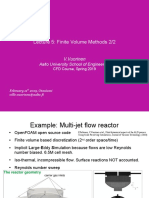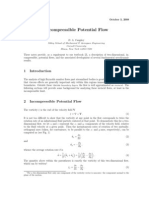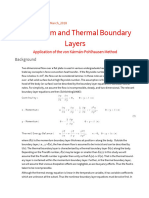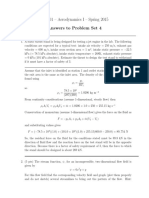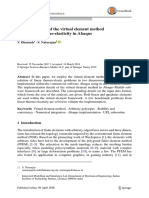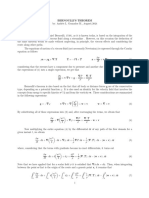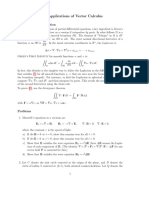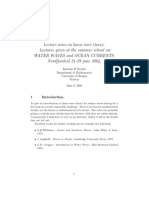HW 3
Uploaded by
mehmet.n.aydin35HW 3
Uploaded by
mehmet.n.aydin35Department of Aerospace Engineering @ METU
AEE305 Numerical Methods
2023-2024 Fall
HW#3
Consider potential (inviscid, irrotational, incompressible) flows over an airfoil. Potential flows
are governed by the Laplace’s equation:
∂ 2ϕ ∂ 2ϕ
∇2 ϕ = + =0
∂x2 ∂y 2
where ϕ is called the velocity potential, whose gradient provides the velocity field and satisfies
the irrotatitonality condition:
∂ϕ ∂ϕ
V⃗ = ∇ϕ
⃗ −→ u⃗i + v⃗j = ⃗i + ⃗j ⃗ × ∇ϕ
note that ∇ ⃗ =0
∂x ∂y |{z}
⃗
V
The freestream velocity, V⃗∞ , is imposed at the farfield boundaries, while V⃗n = 0 is imposed on
the airfoil surface.
If a pseudo time derivative is introducted to the Laplace equation equation, it becomes a diffusion
equation:
∂ϕ
= ν∇2 ϕ (ν = 1)
∂t
Note that the steady state solution satisfies the Laplace equation.
1. Solve for the velocity field over the NACA0012 airfoil by Finite Volume method and plot
the streamlines at α = 0 and α > 0. Use the incomplete Matlab code and the grid data
provided.
2. Obtain the pressure coefficient distribution based on Bernoulli’s equation and plot its
contours in the solution domain. Note that Cp = 1p−p ∞
ρ∞ V 2
= 1 − (u2 + v 2 ) (V∞ = 1)
2 ∞
3. Plot the distribution of surface pressure coefficient as an x − y plot and compare against
the panel method prediction.
4. Assume ϕ = 0 as the initial condition and discuss the solution obtained.
5. For a bonus consider a bi-plane configuration.
You might also like
- Hydrodynamic Models of Quantum MechanicsNo ratings yetHydrodynamic Models of Quantum Mechanics10 pages
- Lifting Airfoils in Incompressible Irrotational Flow: AA210b January 13, 2008No ratings yetLifting Airfoils in Incompressible Irrotational Flow: AA210b January 13, 200839 pages
- Poisson and Laplace's Equations: Free Charge!No ratings yetPoisson and Laplace's Equations: Free Charge!7 pages
- 1 Position and Momentum Commutation RelationsNo ratings yet1 Position and Momentum Commutation Relations6 pages
- Vena Contracta: Joseph Henry Laboratories, Princeton University, Princeton, NJ 08544No ratings yetVena Contracta: Joseph Henry Laboratories, Princeton University, Princeton, NJ 085446 pages
- Solution of Similarity Transform Equations For Boundary Layers Using SpreadsheetsNo ratings yetSolution of Similarity Transform Equations For Boundary Layers Using Spreadsheets7 pages
- Analytical_models_for_temperature_predic (1)No ratings yetAnalytical_models_for_temperature_predic (1)8 pages
- Waves On The Water Surface Mathematical Models Part 2No ratings yetWaves On The Water Surface Mathematical Models Part 222 pages
- Chapter 9 Flow Over Immersed Bodies: Basic ConsiderationsNo ratings yetChapter 9 Flow Over Immersed Bodies: Basic Considerations37 pages
- Msci Examination: Phy-415 (Msci 4242) Relativistic Waves and Quantum FieldsNo ratings yetMsci Examination: Phy-415 (Msci 4242) Relativistic Waves and Quantum Fields7 pages
- AE 301 - Aerodynamics I - Spring 2015 Answers To Problem Set 4No ratings yetAE 301 - Aerodynamics I - Spring 2015 Answers To Problem Set 47 pages
- Numerical Analysis: Mass Transport Under WavesNo ratings yetNumerical Analysis: Mass Transport Under Waves19 pages
- Implementation of The Virtual Element Method For Coupled ThermomechanicalNo ratings yetImplementation of The Virtual Element Method For Coupled Thermomechanical22 pages
- The Heat and Wave Equations in 2D and 3DNo ratings yetThe Heat and Wave Equations in 2D and 3D39 pages
- 2 Quantum Theory of Spin Waves: 2.1 Charged Particle in An Electromagnetic FieldNo ratings yet2 Quantum Theory of Spin Waves: 2.1 Charged Particle in An Electromagnetic Field35 pages
- Ch. VIII Potential Flow and Computational Fluid Dynamics: Review of Velocity-Potential ConceptsNo ratings yetCh. VIII Potential Flow and Computational Fluid Dynamics: Review of Velocity-Potential Concepts5 pages
- Solvability of Vekua-Type Periodic Operators and Applications To Classical EquationsNo ratings yetSolvability of Vekua-Type Periodic Operators and Applications To Classical Equations10 pages
- Problems in Quantum Mechanics: Third EditionFrom EverandProblems in Quantum Mechanics: Third EditionD. ter Haar3/5 (2)







